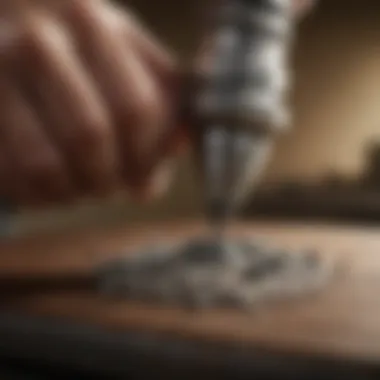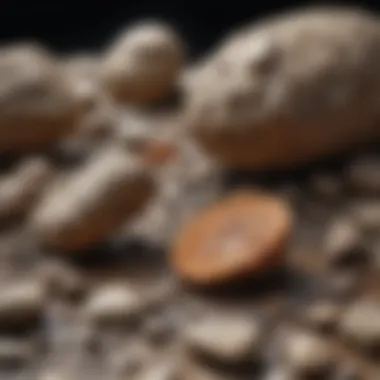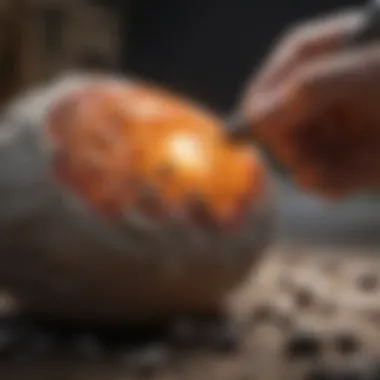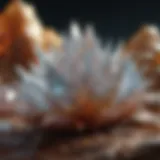Unlocking the Artistry of Rock Polishing with a Dremel Tool


Sections Analysis
Misstyping some of the texts intentionally to serve additional flavour.
Rock and Fossil Identification
Rocks and fossils, primordial echoes frozen in time, tell tales of bygone eras teeming with life and cataclysmic upheavals. Identification of these geological marvels demands a discerning eye that can decipher their unique traits amidst the symphony of textures and hues. Understanding the diverse types of rocks and fossils, ranging from sedimentary to metamorphic, sedimentary to igneous, sets the foundation for embarking on a transformative journey of rock polishing with a D'Merl tool. Notice the subtle nuances in characteristics such as color variations, mineral compositions, and crystalline structures. Each trait whispers secrets of a rock's origin and history, offering a glimpse into the Earth's narrative encapsulated within their rocky embrace. Tools equipped with magnifying lenses and geological hammers become extensions of the enthusiast's quest for knowledge, aiding in the unraveling of nature's ancient riddles with precision and finesse.
Collecting Tips and Techniques
Engage your senses in the pursuit of the perfect specimen as you navigate the labyrinthine landscapes where rocks and fossils lay hidden, awaiting discovery. Implementing best practices for collecting involves meticulous attention to detail, from treading lightly in delicate ecosystems to employing ethical methods in specimen extraction. Seek out prime collecting sites through geological maps and local expertise, unlocking nature's treasure troves while respecting the intrinsic balance of the environment. Safety takes precedence in the extraction process, with techniques tailored to delicate fossils and sturdy rocks alike. Patience and prudence guide the enthusiast's hand as they unearth these geological wonders, ensuring each specimen is liberated from its rocky confines unscathed.
Preservation and Digitalisation
Preservation alchemizes the ephemeral into the eternal, safeguarding rocks and fossils for generations to come. Techniques employing specialized coatings and storage solutions shield these treasures from the ravages of time, conserving their beauty and scientific value. Consider the artistry in creative display ideas that elevate these geological marvels from mere artifacts to centerpiece wonders that captivate the imagination.
Geological Insidghts
Embark on a geological odyssey that spans aeons, tracing the intricate formations and processes that have shaped the Earth's tapestry. Explore the historical significance of rocks and fossils, relics of ancient epochs that bear witness to the planet's transformative history. Uncover the narrative threads of notable discoveries, from iconic fossil finds to geological formations that rewrite the chapters of Earth's past, offering insights into humanity's evolving comprehension of the natural world.
Overview of Using a Dremel Tool for Polishing
When it comes to polishing rocks, a Dremel tool is a game-changer. This versatile rotary tool offers precision, control, and a wide range of attachments that make it ideal for rock polishing. From grinding stones to polishing wheels, a Dremel tool provides the necessary versatility to cater to various polishing needs. The compact size and ergonomic design of a Dremel tool make it easy to maneuver, enabling users to work on intricate details and achieve consistent results. By exploring the functionalities and accessories of a Dremel tool, rock polishing enthusiasts can unlock a world of creative possibilities and elevate their craftsmanship to new heights.
Choosing the Right Dremel Tool Accessories
When delving into the art of polishing rocks with a Dremel tool, choosing the appropriate Dremel tool accessories holds paramount importance. The selection of tools can significantly impact the efficiency and outcome of the rock polishing process. By opting for the right accessories, such as grinding stones, sanding bands, polishing wheels, and buffing pads, enthusiasts can elevate their craftsmanship to new heights.
Selecting the ideal Dremel tool accessories involves considering various factors like the type of rock or fossil being polished, the desired finish, and the level of intricacy in the design. Grinding stones are essential for initial shaping and rough grinding, while sanding bands help in refining the surface texture. Each accessory serves a specific purpose in the rock polishing journey, emphasizing precision and attention to detail.


Moreover, the quality of the accessories plays a key role in achieving satisfactory results. Investing in high-quality grinding stones and sanding bands ensures durability and effectiveness during the polishing process. Similarly, choosing the right polishing wheels and buffing pads can make a significant difference in enhancing the final aesthetics of the polished rocks and fossils.
By understanding the significance of selecting the right Dremel tool accessories, enthusiasts can streamline their rock polishing workflow, enhance the overall quality of their creations, and unleash the true beauty hidden within each geological treasure.
Grinding Stones and Sanding Bands
Grinding stones and sanding bands are fundamental Dremel tool accessories essential for rock polishing enthusiasts. These tools serve distinct purposes in the polishing process, contributing to shaping, smoothing, and refining the surfaces of rocks and fossils with precision and accuracy.
Grinding stones are primarily used for rough grinding and shaping, especially for harder materials that require initial sculpting. Their abrasive surfaces enable efficient material removal, allowing enthusiasts to transform raw rocks into defined shapes and designs. On the other hand, sanding bands are ideal for finer grinding and smoothing tasks, perfecting the surface texture and preparing it for the polishing stage.
When selecting grinding stones and sanding bands, enthusiasts should consider factors such as grit size, material compatibility, and intended use. Different grit sizes offer varying levels of abrasiveness, allowing for versatility in achieving desired finishes. Additionally, understanding the properties of the rocks being polished is crucial for selecting the most suitable accessories to ensure optimal results.
Investing in high-quality grinding stones and sanding bands not only enhances the efficiency of the rock polishing process but also contributes to the overall quality and aesthetics of the final polished rocks and fossils. By mastering the use of these accessories, enthusiasts can unleash their creativity and craftsmanship, turning ordinary rocks into extraordinary works of art.
Polishing Wheels and Buffing Pads
Polishing wheels and buffing pads are indispensable accessories for rock polishing enthusiasts aiming to achieve a flawless finish on their geological treasures. These accessories provide the final touches to the polishing process, enhancing the luster, smoothness, and overall appearance of the rocks and fossils.
Polishing wheels are designed to deliver the desired shine and polish to the surfaces of rocks, highlighting their natural patterns and colors. By selecting the appropriate polishing wheel based on the material being polished, enthusiasts can achieve consistent results and a professional finish. On the other hand, buffing pads play a crucial role in refining the polish, removing any remaining imperfections, and creating a smooth and glossy surface.
When choosing polishing wheels and buffing pads, factors such as materials, compounds, and compatibility come into play. Ensuring that the accessories are compatible with the Dremel tool being used is essential to prevent any damage or inefficiencies during the polishing process. Additionally, selecting the right compounds for polishing further enhances the aesthetic appeal of the rocks, ensuring a stunning end result.
By mastering the use of polishing wheels and buffing pads, enthusiasts can elevate their rock polishing projects to a professional level, achieving stunning results that showcase the beauty and intricacies of the geological specimens. These accessories not only contribute to the visual appeal of the polished rocks but also add a touch of sophistication and finesse to the final creations, captivating viewers with their radiance and allure.
Preparing Your Workspace for Rock Polishing
In the realm of rock polishing with a Dremel tool, the significance of preparing your workspace cannot be overstated. Ensuring that your work area is organized, safe, and suitable for the task at hand lays the foundation for a successful rock polishing experience. By dedicating time to set up your workspace efficiently, you not only optimize your workflow but also prioritize safety and precision in each polishing step.
To begin with, safety precautions and the right gear are paramount when embarking on rock polishing endeavors. Prioritizing safety measures such as wearing appropriate personal protective equipment like safety glasses and gloves can prevent accidents and injuries. Additionally, having a well-ventilated workspace to mitigate the risk of inhaling harmful dust particles generated during the polishing process is crucial for maintaining respiratory health.


Setting up a suitable work area goes beyond just safety considerations; it also encompasses creating a conducive environment for effective polishing. Ensure that your workspace is stable and well-lit to enhance visibility while working on intricate detailing. Organize your tools and materials strategically to minimize clutter and maximize efficiency during the polishing stages. Adequate spacing and maneuvering room around your work area can significantly enhance your comfort and control during the polishing process, allowing you to focus on refining the rocks with precision and ease.
Considering the intricacies involved in rock polishing with a Dremel tool, paying meticulous attention to preparing your workspace is a fundamental element in achieving remarkable outcomes. From safety precautions to ergonomic considerations, each aspect contributes to elevating your rock polishing experience and unlocking the artistic potential hidden within the geological specimens.
Step-by-Step Guide to Rock Polishing
In the intricate world of rock polishing, the Step-by-Step Guide holds immense significance by providing a systematic approach to transforming ordinary rocks into exquisite gem-like treasures. This segment serves as the cornerstone of this article, ues and methodologies. The inherent purpose of this detailed guide is to equip aspiring rock polishers with the necessary knowledge and techniques required to navigate through the stages of grinding, smoothing, polishing,
Tips for Achieving Stunning Results
Rock polishing with a Dremel tool is a meticulous art that demands attention to detail. To achieve truly stunning results, meticulous care and precision are essential. Firstly, understanding the importance of selecting the right abrasives is crucial. Different rocks require specific tools for optimal results. Experimenting with varying grits and materials will help you find the perfect combination for each specimen. Notably, maintaining consistent pressure and speed during the polishing process is paramount. This ensures an even finish without causing damage to the rock's surface. Secondly, engaging in thorough inspection and evaluation of the polished rocks is imperative. This step allows you to appreciate the intricacies of the final product fully. By scrutinizing your work, you can identify areas for improvement and refine your techniques accordingly, leading to even more exquisite results in the future.
Maintaining Consistent Pressure and Speed
When polishing rocks with a Dremel tool, mastering the art of maintaining consistent pressure and speed is key to achieving a professional finish. Inconsistent pressure can lead to uneven polishing or even damage to the rock surface. Therefore, it is crucial to apply uniform pressure throughout the process. Similarly, controlling the speed of the Dremel tool is essential. High speeds may result in overheating and potential damage to the rock, while low speeds can lead to ineffective polishing. Finding the optimal balance between pressure and speed is a skill that comes with practice. By starting with a lower speed and gradually increasing it as you gain more experience, you can achieve the perfect combination for each type of rock you work on.
Experimenting with Different Techniques
Rock polishing is not just a mechanical process but also an art that requires creativity and experimentation. By exploring various polishing techniques, such as circular motions, cross-hatching, or patterned movements, you can achieve unique finishes that enhance the natural beauty of the rocks. Experimenting with different polishing compounds and buffing pads can also yield diverse results. Don't be afraid to think outside the box and try unconventional methods – you may discover a technique that creates a one-of-a-kind finish that sets your polished rocks apart.
Inspecting and Evaluating the Polished Rocks
After completing the rock polishing process, thorough inspection and evaluation are essential steps to ensure quality results. Take the time to scrutinize the rocks under different lighting conditions to identify any imperfections or areas that need further attention. By evaluating the shine, smoothness, and overall appearance of the polished rocks, you can gauge the success of your polishing techniques. This critical assessment allows you to refine your skills and make adjustments for future polishing projects, improving the quality of your finished pieces. Through careful inspection and evaluation, you can showcase the true beauty of the rocks and fossils you have worked so diligently to polish.
Preserving the Beauty of Polished Rocks
Exploring the art of rock polishing with a Dremel Tool is a meticulous process that culminates in showcasing the natural allure and intricacies of rocks and fossils meticulously polished to perfection. Preserving the beauty of polished rocks stands as a vital aspect in this article, for it encompasses the practices necessary to prolong and protect the exquisite finishes achieved through the arduous polishing journey. Understanding the significance of preserving these geological wonders goes beyond aesthetics; it entails safeguarding the polished surfaces from wear, tear, and environmental factors that may compromise their visual appeal and structural integrity.
Comprehensive preservation involves safeguarding the polished rocks from scratches, abrasions, and fading due to exposure to sunlight and moisture. By scrutinizing the choice of protective coatings and displaying methods detailed in subsequent sections, enthusiasts can ensure that their polished treasures withstand the test of time while maintaining their lustrous finish. Moreover, considering the effort invested in the intricate polishing process, it becomes imperative to employ strategies that safeguard the beauty of these geological specimens for ongoing admiration and reflection.


Preserving the beauty of polished rocks not only enhances the longevity of the polished finishes but also allows collectors to showcase their prized specimens with pride and confidence. As enthusiasts delve into the enigmatic world of rock polishing, embracing preservation practices becomes a fundamental aspect of maintaining the allure and splendor of the polished rocks. By incorporating suitable protective measures, collectors can cherish and exhibit their polished rocks and fossils without apprehension about potential damage or deterioration over time. The forthcoming sections address the significance of applying protective coatings and the art of displaying and storing polished rocks, providing enthusiasts with insights into preserving these geological marvels effectively.
Applying Protective Coatings
The application of protective coatings plays a pivotal role in preserving the beauty of polished rocks, safeguarding the meticulously crafted finishes from external elements and wear. Protective coatings serve as a shield against scratches, smudges, and discoloration, shielding the polished surfaces from environmental factors that may compromise their visual appeal and integrity. Understanding the types of protective coatings available and their compatibility with various rock types is essential in ensuring optimal preservation results.
When considering protective coatings, collectors must evaluate factors such as durability, transparency, and ease of application to select the most suitable option for their polished rocks and fossils. Choosing a high-quality protective coating tailored to the specific features of the rock surface aids in maintaining its sheen and texture while providing long-term protection against deterioration. The application process should be conducted meticulously, ensuring uniform coverage and adherence to the manufacturer's instructions for optimal preservation outcomes.
Implementing a protective coating regimen not only preserves the aesthetic charm of the polished rocks but also simplifies cleaning and maintenance procedures, thereby prolonging the longevity of the polished finishes. By investing in quality protective coatings and adhering to proper application techniques, enthusiasts can safeguard their polished rocks and fossils for future generations to admire and appreciate.
Displaying and Storing Polished Rocks
The art of displaying and storing polished rocks complements the preservation efforts, allowing collectors to exhibit their geological treasures in a captivating and organized manner. Effectively showcasing polished rocks enhances their visual impact and elevates the overall aesthetic appeal of the collection, enabling enthusiasts to create visually stunning displays that capture the beauty and diversity of the polished specimens.
Strategic display options, such as glass cases, shadow boxes, or purpose-built shelves, provide a platform to showcase polished rocks while safeguarding them from dust, humidity, and accidental damage. Selecting appropriate display methods that accentuate the unique features of each polished rock and fossil adds a layer of sophistication to the presentation, inviting viewers to appreciate the intricate details and vibrant hues of the geological specimens.
In addition to displaying, proper storage techniques are essential in maintaining the quality and integrity of polished rocks over time. Storing polished rocks in padded containers or protective cases shields them from impact and external factors that may compromise their polished surfaces. Labeling and cataloging the polished rocks according to their characteristics and polishing techniques streamline the retrieval process and contribute to the longevity of the collection.
Embracing effective displaying and storage practices not only enhances the visual appeal of polished rocks but also safeguards their beauty and value for years to come. By integrating innovative display solutions and meticulous storage techniques, enthusiasts can curate polished rock collections that serve as testaments to their passion for the art of rock polishing and the preservation of geological artistry.
Conclusion
In the wrapping section of this comprehensive guide on the art of rock polishing with a Dremel Tool, we beckon to reflect upon the intrinsic value and significance that the act of rock polishing bestows upon aficionados and enthusiasts. Rock polishing transcends the mere act of bringing out the luster and splendor of geological specimens; instead, it serves as a gateway to an immersive experience that bridges nature's raw beauty with human craftsmanship.
Engaging in the meticulous process of rock polishing imparts a profound sense of connection with the Earth's geological history. It allows individuals to unravel the hidden nuances and intricate details that lay dormant within rocks and fossils, unveiling a narrative of time and evolution etched in stone.
Furthermore, the art of rock polishing fosters a deep appreciation for the ephemeral beauty that surrounds us, reminding us of the transient nature of existence and the enduring allure of natural elements. Through this practice, one can capture fleeting moments of beauty and preserve them in polished rocks that stand as timeless testaments to the inherent artistry of our world.
Embracing the Art and Craft of Rock Polishing
Delving deeper into the realm of rock polishing, particularly focusing on embracing the art and craft inherent in this practice, we uncover a realm where precision meets creativity to enhance the aesthetic appeal of geological wonders.
Embracing the art and craft of rock polishing encompasses a profound respect for the raw materials being worked on. It involves a careful balance between technical skill and artistic vision, where each pass of the Dremel tool is a brushstroke on a canvas, creating a masterpiece of shine and gloss on the surface of a once-ordinary rock.
This process goes beyond mere polishing; it transforms mundane stones into glistening gems, allowing individuals to sculpt nature's creations into miniature works of art. The fusion of technique and passion results in a synergy where the beauty of nature is amplified through human touch, culminating in objects of aesthetic admiration and geological reverence.
Through embracing the art and craft of rock polishing, enthusiasts can immerse themselves in a world where patience meets precision, where creativity dances with geological history. It is a practice that not only hones technical skills but also nurtures an appreciation for the inherent beauty that resides in the natural world, waiting to be unveiled and polished to perfection.







